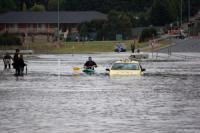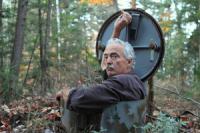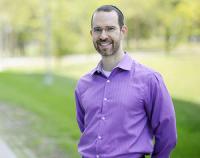-
Over time, nuisance flooding can cost more than extreme, infrequent events
Global climate change is being felt in many coastal communities of the United States, not always in the form of big weather disasters but as a steady drip, drip, drip of nuisance flooding. Rising sea levels will cause these smaller events to become increasingly frequent in the future, and the cumulative effect will be comparable to extreme events such as Hurricane Katrina or Superstorm Sandy.
-
-
New climate model predicts likelihood of Greenland ice melt, sea level rise, dangerous temperatures
A new computer model of accumulated carbon emissions predicts the likelihood of crossing several dangerous climate change thresholds. These include global temperature rise sufficient to lose the Greenland Ice Sheet and generate seven meters of long-term sea level rise, or tropical region warming to a level that is deadly to humans and other mammals.
-
-
Improving climate change modeling by including variables such as inequality, consumption, and population

A new scientific paper by an international team of distinguished scientists, including five members of the National Academies, argues that there are critical two-way feedbacks missing from current climate models that are used to inform environmental, climate, and economic policies. The most important inadequately modeled variables are inequality, consumption, and population. The authors present extensive evidence of the need for a new paradigm of modeling that incorporates the feedbacks that the Earth System has on humans, and propose a framework for future modeling that would serve as a more realistic guide for policymaking and sustainable development.
-
-
Sea-level rise in Southeast Asia 6,000 years ago relevant for coastal dwellers today
For the 100 million people who live within three feet of sea level in East and Southeast Asia, the news that sea level in their region fluctuated wildly more than 6,000 years ago is important, according to researchers. This is because those fluctuations occurred without the assistance of human-influenced climate change. Such a change in sea level could happen again now, on top of the rise in sea level that is already projected to result from climate change. This could be catastrophic for people living so close to the sea.
-
-
Last year’s El Niño resulted in unprecedented erosion of the Pacific coastline
Last winter’s El Niño might have felt weak to residents of Southern California, but it was in fact one of the most powerful climate events of the past 145 years. If such severe El Niño events become more common in the future as some studies suggest they might, the California coast — home to more than twenty-five million people — may become increasingly vulnerable to coastal hazards. And that’s independent of projected sea level rise.
-
-
Humans now affect Earth system more than natural forces
Humans are causing the climate to change 170 times faster than natural forces, new research finds. The study for the first time came up with a mathematical equation to describe the impact of human activity on the Earth system, known as the Anthropocene equation. Over the past 7,000 years the primary forces driving change have been astronomical — driving a rate of change of 0.01 degrees Celsius per century. “Human-caused greenhouse gas emissions over the past forty-five years have increased the rate of temperature rise to 1.7 degrees Celsius per century, dwarfing the natural background rate,” the researchers say.
-
-
Trend: Americans building “doomsday bunkers” in large numbers

It may be a fad of the moment, or an indication of a deeper trend, but people across the United States are building and buying “doomsday bunkers” in large numbers. It is not exactly a new business, but demand for underground bunkers is at an all-time high according to industry insiders. A Texas bunker company saw its sales increase 400 percent in the past two months.
-
-
Recovering from disasters: Social networks matter more than bottled water and batteries

Almost six years ago, on Friday, March 11, 2011, Japan faced a paralyzing triple disaster: a massive earthquake, tsunami, and nuclear meltdowns that forced 470,000 people to evacuate from more than 80 towns, villages and cities. My colleagues and I investigated how communities in the hardest-hit areas reacted to these shocks, and found that social networks - the horizontal and vertical ties that connect us to others - are our most important defense against disasters. As communities around the world face disasters more and more frequently, I hope that my research on Japan after 3/11 can provide guidance to residents facing challenges. While physical infrastructure is important for mitigating disaster, communities should also invest time and effort in building social ties.
-
-
World leaders urged to take action to avert existential global risks
World leaders must do more to limit risk of global catastrophes, according to a report by Oxford academics. He academic define global catastrophe as a risk “where an adverse outcome would either annihilate Earth-originating intelligent life or permanently and drastically curtail its potential.” Three of the most pressing possible existential risks for humanity are pandemics, extreme climate change, and nuclear war.
-
-
Current climate change models understate the problem
A new study on the relationship between people and the planet shows that climate change is only one of many inter-related threats to the Earth’s capacity to support human life. An international team of distinguished scientists, including five members of the National Academies, argues that there are critical components missing from current climate models that inform environmental, climate, and economic policies.
-
-
Broader updrafts in severe storms may increase likelihood of damaging hail
Hailstorms in the United States account for more than $1 billion in damage annually, wreaking havoc on homes, businesses, automobiles, aircraft and agriculture. Recently, these damage totals have increased as people move into hail-prone regions. On 12 April 2016, a supercell storm devastated the San Antonio metropolitan area with large hail, producing approximately $1.36 billion in damage.
-
-
Extreme fires will increasingly be part of our global landscape
Wildfire burned more than 10 million acres in the United States in 2015, and cost over $2 billion to suppress. There were 23 million landscape fires around the world between 2002 and 2013, and researchers define 478 of them as extreme wildfire events. Increasingly dangerous fire weather is forecast as the global footprint of extreme fires expands.
-
-
Disaster Survival Skills launches new disaster preparedness calculator
Seismologists have warned for years about the danger of a so-called “megaquake” devastating the Pacific Northwest upon the rupture of the region’s Cascadian Subduction Zone. Disaster Survival Skills launched its brand-new online Family disaster preparedness calculator. After in-putting a few simple pieces of information, Disaster Survival Skills site visitors will receive a customized list of disaster supplies and advice that can be used to prepare for earthquakes, floods, and other emergencies.
-
-
Deflecting asteroids to prevent their collision with Earth
On 15 February 2013, an asteroid with a diameter of approximately eighteen meters exploded over the Russian town of Chelíabinsk, producing thousands of meteorites that fell to Earth. Many meteorites hit the ground each year, each with a total mass exceeding one ton. An international project provides information on the effects a projectile impact would have on an asteroid. The aim of the project is to work out how an asteroid might be deflected so as not to collide with the Earth.
-
-
Psychological “vaccine” could immunize public against fake news on climate change
New research finds that misinformation on climate change can psychologically cancel out the influence of accurate statements. However, if legitimate facts are delivered with an “inoculation” – a warning dose of misinformation – some of the positive influence is preserved.
-
More headlines
The long view
Trump Aims to Shut Down State Climate Policies
President Donald Trump has launched an all-out legal attack on states’ authority to set climate change policy. Climate-focused state leaders say his administration has no legal basis to unravel their efforts.
